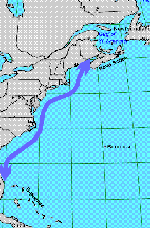 |
 |
 |
 |
 |
 |
 |
Right Whale Migration Update: February 3, 1999
Today's Report Includes:
- Ahoy from the Stellwagen Bank National Marine Sanctuary
- Most Endangered of the Great Whales
- Rare Sighings of Some Rare Whales
- Challenge Questions #1 and #2
Greetings from the Stellwagen Bank National Marine Sanctuary
Ahoy there, from the Stellwagen Bank National Marine Sanctuary to all of you landlubbers out there. This is Anne Smrcina, education coordinator of the Sanctuary -- and a landlubber myself. Our offices have just moved from Plymouth to Scituate, Massachusetts, but the actual Sanctuary is totally at sea. The boundary for this marine protected area runs from three miles south of Cape Ann to three miles north of Cape Cod, encompassing 842-square miles of open water at the mouth of Massachusetts Bay.
Most Endangered of the Great Whales
|
|
|
Range of the Right Whale |
Right whales were once found widely along the east and west coasts of the North Atlantic. But hunting pressures many hundreds of years ago, leading right up until the 1930s, almost wiped them out completely. But strict hunting bans over some 65 years, have not brought them back to levels that would assure their survival.
Rare Sightings of Some Rare Whales
For today's right whale report, I have the latest update from the field research team down in Georgia and the right whale alert network in Massachusetts.
As I mentioned in today's JN Humpback Whale Report, unlike some of the other Journey North correspondents, I am not a scientist, but a public outreach specialist with background in science journalism, education and ecology. I will serve as an intermediary for many field researchers and scientists who are working on cetacean studies. My reports will include sighting information from various locations, news reports on issues concerning whale conservation, and some of the latest scientific findings. My position at the Stellwagen Bank National Marine Sanctuary provides me with the opportunity to work with some of the best cetacean scientists in the world.
Chris Slay, a researcher with the New England Aquarium has been studying right whales for several years in the calving grounds off the Georgia/Florida coastline (31.75N, 81.50 W). He reports that they have only seen two mother-calf pairs so far this year -- which is very discouraging considering the dire condition of the stock. As he says, "It doesn't take much of a mortality rate to offset that level of recruitment." What he means by this is that, if two is the total number of births, any more than two deaths this year may mean a continued dwindling of the population. He also noted that, "it doesn't make it very easy to find a subject for the study we planned."
His research team was trying to tag a whale with a radio transmitter which would allow them to study the whale's movements. Considering there were only two sightings, they were lucky to find one of the mothers (#1612, most right whales have numbers, not names) and tag her on January 20th. They were able to track her for two days until weather forced the scientists in to shore; but they were able to reacquire the signal on the 25th and continue the study.
Here are the season's first Challenge Questions for you:
Challenge Question #1
"Why would scientists want to know about the LOCAL movements of right whales?"
Here in Massachusetts, aerial and boat surveys have located 21 right whales in Cape Cod Bay in a 3.8 nautical mile radius from coordinates: 41.83N, 70.33 W.
Challenge Question #2
"It seems that there are right whales in southern and northern waters at the same time. What's happening here?"
(To respond
to this Challenge Question, please follow the instructions at the end of this report.)
This is Anne Smrcina of the Stellwagen Bank National Marine Sanctuary signing off
for this week.
How to Respond to Today's Right Whale Challenge Questions:
Please answer ONLY ONE question in each e-mail message!:
1. Address an E-mail message to: jn-challenge-rwhale@learner.org
2. IMPORTANT: In the Subject Line of your message write: Challenge Question #1 (or Challenge Question #2).
3. In the body of the EACH message, give your answer to ONE question above.
The Next Right Whale Migration Update will Be Posted on February 17, 1999.
Copyright 1999 Journey North. All Rights Reserved. Please send all questions, comments, and suggestions to our feedback form
 |
 |
 |
 |
 |
 |
|

